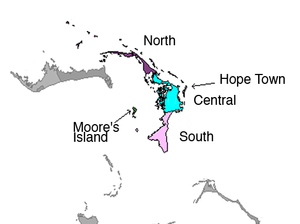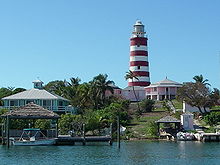- Abaco Islands
-
Coordinates: 26°28′N 77°05′W / 26.467°N 77.083°W
Abaco 
The five administrative districts of the AbacosGeography Location Atlantic Ocean Archipelago Bahamas Area 1,681 km2 (649 sq mi) Country Island Abaco Largest city Marsh Harbour (pop. 5,728) Demographics Population 16,692 (as of 2000) Density 9.9 /km2 (25.6 /sq mi) Ethnic groups Blacks, Whites, Mixed The Abaco Islands lie in the northern Bahamas and comprise the main islands of Great Abaco and Little Abaco, together with the smaller Wood Cay, Elbow Cay, Lubbers Quarters Cay, Green Turtle Cay, Great Guana Cay, Castaway Cay, Man-o-War Cay, Stranger's Cay, Umbrella Cay, Walker's Cay, Little Grand Cay, and Moore's Island. Administratively, the Abaco Islands constitute five of the 31 Districts of the Bahamas: North Abaco, Central Abaco, South Abaco, Moore's Island, and Hope Town. Towns in the islands include Marsh Harbour, Hope Town, Treasure Cay, Coopers Town, and Cornishtown.
Contents
History
The Abaco Islands were first inhabited by the Lucayan. The first European settlers of the islands were Loyalists fleeing the American Revolution who arrived in 1783, as was also the case at Cat Island. These original Loyalist settlers made a modest living by salvaging wrecks, by building small wooden boats, and by basic farming.
Prior to the 1970s, a group of American businessmen, arms traffickers, supporters of free enterprise, a black agent of the information services, and a Member of Parliament of the British House of Lords planned the independence of Abaco, or that would have a UK dependency status similar to that of Anguilla. Abaco was to be a utopia for businessmen fearing socialism.
They would promise one acre (4,000 m²) to each of the natives on the island. This would have left thousands of acres for realtors and their financial backers. At least one flag was designed, combining the Hope Town Lighthouse with a Union Flag.
The British government had no interest in this scheme, which in any case would have been strongly opposed by the national government in Nassau. Finally, the locals did not support the plan, perhaps because unspoken racial issues are alleged to have mixed into it. In any event, the Abaco Independence Movement was quelled by 1975.
Demographics
The combined population of the islands is about 13 000, and the principal settlement and capital is Marsh Harbour. The racial make up is about 50% white and 50% black.
In addition to Marsh Harbour there are several other settlements on Great Abaco including Cherokee Sound, Coopers Town, Crossing Rock, Green Turtle Cay, Hope Town, Little Harbour, Rocky Point, Sandy Point, Spring City, Treasure Cay, Wilson City, and Winding Bay.
Surrounding Great Abaco are several smaller islands known as cays (pronounced key), many of which are popular with tourists visiting the islands. A few notable cays include Castaway Cay (formerly Gorda Cay), Elbow Cay, the Grand Cays, Great Guana Cay, Man-O-War Cay, Green Turtle Cay, Moore's Island, and Walker's Cay.
Activities
The islands are a noted base for sailing activities in the Bahamas, as well as resort tourism.
 The red and white striped lighthouse at Hope Town in the Abaco Islands, is a noted local landmark.
The red and white striped lighthouse at Hope Town in the Abaco Islands, is a noted local landmark.
The Abacos Islands in the Bahamas have four national parks that attract tourists: Pelican Cays Land & Sea Park, Abaco Wild Horse Preserve, Man-O-War Cay, and Great Guana Cay.
Transportation
Marsh Harbour Airport and Treasure Cay Airport serve the islands. Marsh Harbour Airport is famous because of the nine lifes lost among them a famous popstar named Aaliyah Outer islands can be reached by ferries operated by Alburys Ferry Service and Green Turtle Ferry. Bahamas Fast Ferry operates between Nassau and Sandy Point on the southern end of Abaco. On the main island cars and boat are available. While on some of the smaller cays, golf carts and boats are the main mode of transportation, along with bikes or scooters.
Environment
The Abaco Islands boast important natural areas, especially important coral reef areas, barrier-island terrestrial habitats and large forests of Bahamian Pine (Pinus caribaea var. bahamensis), some of which still contain old-growth trees. As development expands in the Abacos, local groups have begun to more fiercely fight for the preservation of their natural resources, such as in the development case on Great Guana Cay.[1]
Notable species include the Bahamian subspecies of Cuban Amazon (Amazona leucocephala bahamensis), which exists only in Cuba, the Cayman Islands, the southern Bahamas and Abaco. This population is unique in that nests in limestone solution cavities rather than tree cavities. Abaco is also known for its intact elkhorn and staghorn coral structures, and for its critically endangered breed of feral horse, the Abaco Barb.
References
- ^ Teresa Castle, Chronicle Foreign Service (2006-02-13). "Reef defenders in Bahamas sue over mega-resort / S.F. developer sees Baker's Bay as model for sensitive construction on fragile islands". Sfgate.com. http://www.sfgate.com/cgi-bin/article.cgi?f=/c/a/2006/02/13/MNG88H7E5U1.DTL&hw=guana+cay&sn=001&sc=1000. Retrieved 2010-01-16.
Categories:- Islands of the Bahamas
- Abaco Islands
Wikimedia Foundation. 2010.
